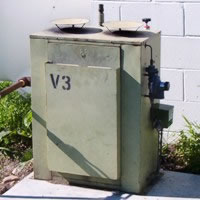Propane Vaporizers

Commercial and industrial propane applications using high demand LP Gas equipment will often incorporate propane vaporizers to satisfy appliance BTU requirements. Vaporizers are used when equipment or appliance demand exceed the vaporizing capacity of the tank. In other words, vaporizers are used to supply the required amount of propane gas when the tank can't keep up with the downstream appliance demand on its own and placing a much larger tank, with higher vaporization capacity would not be practical. LP Gas vaporizers work with liquid propane at a location apart from the tank with liquid being piped to the vaporizing equipment for gas vaporization.
LP Gas Vaporizer Purpose
When appliance demand is expressed in gallons of propane per minute (GPM), a propane vaporizer will likely be needed. Propane vaporizers operate by using liquid propane to produce vapor (propane gas) for downstream equipment. Vaporizers serve to meet the demands of equipment because the environmental conditions present challenges to container vaporization capacity, such as in cold temperatures or because LP Gas appliance vapor requirements are extremely high. Vaporizers can't be installed without changing the propane withdrawal method of the propane tank. This is crucial to understand because propane tanks supply vaporizers with liquid and therefore, the temporary installation and use of a vaporizer isn't always practical or efficient. See propane liquid and vapor for more information.
Propane Direct Fired Vaporizers
Direct fired propane vaporizers use a flame that directly heats the liquid propane which turns it to gas for use in downstream, high vapor demand equipment. Liquid propane is piped from the tank to the vaporizer where it is then heated and in turn, the propane gas vaporization is accelerated. What makes a direct fired vaporizer unique is that the gas used as the heat source is supplied by the same tank(s) supplying the liquid to be vaporized. In other words, the propane used for supplying the heat as well as the liquid propane that is being vaporized both come from the same tank.
It is important to know that some municipalities, locales and jurisdictions may have rules that prevent the installation of a direct fired vaporizer due to location constrains and/or concerns about surrounding activities or structures.
Indirect Fired Propane Vaporizers
Indirect fired propane vaporizers use heat from a supplemental source to heat the liquid propane for its accelerated vaporization. Unlike direct fired vaporizers, this type of vaporization equipment heats the liquid propane with an external source of heat, not with gas from the same propane tank. If the liquid were heated with a propane flame from another propane tank, the equipment would still technically be an indirect fired vaporizer. It's not the type of fuel being used that categorizes a vaporizer as direct or indirect, it's the fuel source that determines the vaporizers classification.
Propane powered vehicles often use vaporizers to boil liquid propane for the accelerated vaporization of propane to meet the high gas demands of the engine. The heat source often used to vaporize the liquid propane is hot water from the radiator. The propane vaporizer has a chamber that hot water is pumped through to heat the liquid propane, causing it to boil and vaporize faster for the requirements of the engine. In short, this type of engine fuel vaporizer becomes part of the water circulation system and indirectly vaporizes the liquid propane for use.
Vaporizing Burners
A vaporizing burner is is the simplest form of propane vaporizer. Vaporizing burners utilize the properties of propane to burn vapor when directly released into the open air. An example of a vaporizing burner would be a liquid propane flame torch. The liquid line runs from the LP Gas container to the torch and once the liquid meets the atmosphere, it vaporizes and once ignited will produce a steady stream of flame. These types of vaporizing burners are used in controlled burns for brush and vegetation removal/management. There are other types of vaporizing burners but this depiction of a liquid service flame torch is the best example of a propane vaporizing burner.
